For athletes looking to get their first muscle-up—whether on the rings or the bar—who may have tried and failed numerous times; who may have studied videos, read progressions, been thoroughly coached and yet still the skill still remains elusive—this article is for you.
For the coach who just can’t seem to understand why their athlete can’t get a muscle-up; who may have analyzed every bit and piece of their technique, but can’t figure out what’s missing—this article is for you.
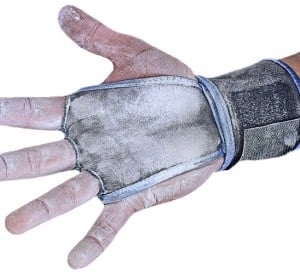
I’ve traveled to numerous CrossFit facilities over the past several years. I’ve been asked to teach the athletes various gymnastic skills, one of the most highly requested being the muscle-up. I’ve seen countless athletes try and fail and I have seen the same athletes try again with my coaching and succeed.
While it does not take athletes long to grasp the basic concept of a muscle-up, a chin-up that transitions into a dip, it’s the finer points that make the difference between success and failure; or even just a strong muscle-up from a weak one. Let’s look at some of those points.

WRONG: Hand is in the center, wrist is off-center
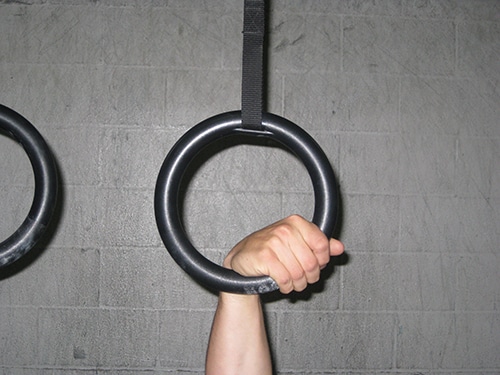
Right: Wrist is in the center, hand is off-center
False Grip: Where’s Your Wrist
While learning a muscle-up with a false grip can be frustrating, the advantage this grip gives is too good to pass up. It gives you a head start for the transition. Setting the false grip correctly will allow for a strong pull when getting over the rings.
If you take a look at the ring, you can imagine it like a clock face with the strap at 12 o’clock on the dial. Too often I see athletes put their hand at 6 o’clock on the dial with their goose-necked wrist. (Image 1)
While at first this seems like a normal false grip, it will in fact prove weak when pulled strongly upon. The load bearing point for the false grip is closer to the wrist than the palm of the hand. Therefore, the wrist needs to sit at 6 o’clock on the ring, not the palm of your hand. (Image 2)
A quick pull on the rings with this latter grip should prove stronger than the former one.
Learn to Relax
While we’re talking about the wrist, let’s discuss which muscles of the lower arm should be engaged when preparing for a muscle-up.

Forearm is tight. Hand is loose.
When your hands are wrapped around the rings or a bar, you may naturally want to squeeze everything to death. If you do this, you’ll lose focus on the real muscles that should be working – the forearms. You can actually hold your grip a bit looser than you’d expect, so that your forearm can flex tighter and keep the false grip set securely. This is in the case of the ring muscle-up. In the case of the bar muscle-up with no false grip, keep a looser grip so that your hand can spin around the bar and your wrists can turn over top of the bar more easily.
Use Your Head
I often equate the muscle-up to climbing up on top of a wall. If you imagine those playground days of climbing, you’ll remember that when you got to the top of the wall, you threw your bodyweight forward. You needed to get your head and shoulders forward, or you would fall backwards off the wall. The same concept applies to the muscle-up.
First, as touched upon in the last section, your wrists need to get above the rings or bar. This is the advantage of the false grip – it already puts your wrists where they need to be. If you do a muscle-up without a false grip, then you’re taxed with having to turn your wrists over quickly enough to support and push your weight. The wrists turn over quickly when you get your head and shoulders forward quickly at the top.
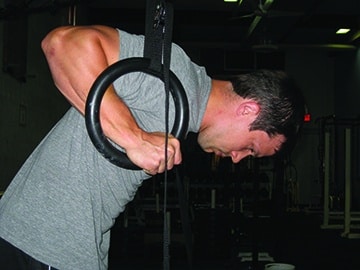
Forearms are not perpendicular to the ground.
On both the bar and the rings, with your wrists over top the apparatus, the next thing in line needs to be your forearms. If your forearms are not perpendicular to the ground, you will fall backward. (Image 4) I see this point overlooked on the rings most often.
When watching an athlete from the side, you can determine if they’ve gotten their head and shoulders forward enough by whether their forearm is perpendicular. Some will keep their head and gaze up too high, and not “turn over” the rings enough.
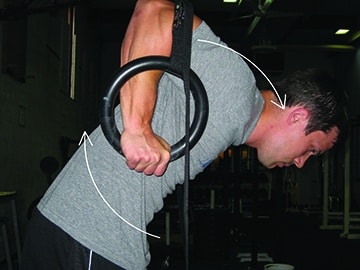
Pull the rings back. Push the head and shoulders forward. Forearms perpendicular to the ground.
When done correctly, the pull of the rings and the push forward of the head and shoulders will create a circular movement in order to get the athlete into their dip. (Image )
Watch an athlete’s forearms to determine whether they’ve got themselves far enough over. Some will simply hold back the turn over for fear of going too far and falling through the rings.



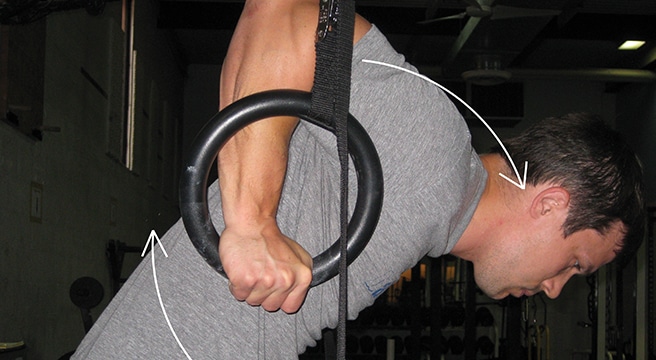








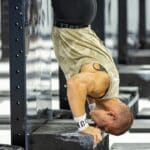

Just want to say a big thanks to Jim for this. I’ve learned a lot from beastskills over the years and this is probably the best muscle up article going! I’m weighing 190lb at just under 5″9 and skills like the muscle up don’t come easy for me, but seeing him perform weighted muscle ups makes me feel weak. some very good tips